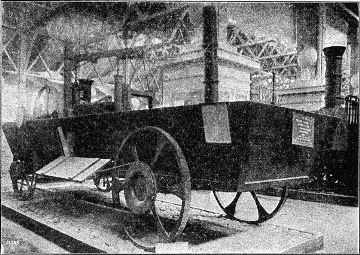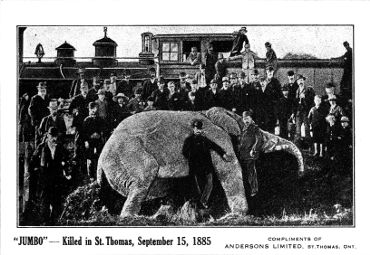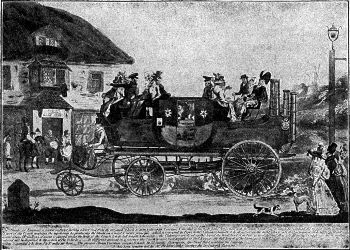Transportation Facts
"All travelling becomes dull in exact proportion to its rapidity."
—John Rusk
31 results found. Go to page:
1 2 The first recorded attempt at flight is from 1020, when Oliver of Malmesbury, an English Benedictine monk, strapped a large pair of wings to his body and tried to soar into the air from Malmesbury Abbey. He fell, breaking both his legs. (source)
The first submarine was invented over 400 years ago. In 1620 Drebbel built a submersible oar-powered vehicle and tested it in the River Thames in London, where it reached a depth of 15 feet. King James I rode in it on one occasion. (source)
![[The first iron bridge in the world]](../images/ironbridge.jpg)
The world's first iron bridge.
The first bridge made out of iron had a span of only 100 feet. It spanned the Severn River at Coalbrookdale and was built in 1777–1778. The bridge still exists today. (source)

Reconstruction of Oliver Evans' automobile.
The first automobile in the United States was built over 200 years ago. In 1804, Philadelphia ordered a steam-dredge from Oliver Evans, inventor of the high-pressure steam engine and other technology. Evans' shop was a mile and a half from the Schuylkill River, so he mounted one of his engines within the dredge-scow and ran the scow on rollers by steam to the river, making this device the first American automobile. When he reached the river Evans substituted a paddle for the rollers and steamed away to Philadelphia, also making this device one of the first steamboats. (source)
North America's first fatal railway accident on a steam-operated railway was on June 17th, 1831, when the boiler exploded on America's first passenger locomotive and the first American locomotive in regular revenue service, the Best Friend of Charleston (whose first revenue run had been on January 15th of that year), killing the fireman. The response by the West Point Foundry, which had built the locomotive, to the boiler failure was by building their next locomotive, the West Point, with a "barrier car", a car loaded with bales of cotton to protect passengers.
![[Best Friend of Charleston]](../images/bestfriend.jpg)
The
Best Friend of Charleston.
(source)

Postcard depicting Jumbo the elephant, killed in St. Thomas, September 15, 1885.
The word "jumbo" comes from the name of Jumbo the circus elephant. Jumbo was killed on September 15, 1885, after being hit by a locomotive in St. Thomas, Ontario, Canada. In 1985, a life-size (3.35 metres tall) plaster statue of Jumbo was unveiled in St. Thomas. It was sculpted in New Brunswick and, ironically, was transported to St. Thomas entirely by truck. (source)
The world's largest building without internal supports is the Goodyear Airship hangar, in Akron, Ohio, which encompasses a volume of 55 million cubic feet. Clouds form in the top of the structure during sudden temperature changes, and it rains.
In 1898, fourteen years before the Titanic sailed in April 1912 on her maiden voyage from Southampton to New York, Morgan Robertson's novel Futility was published. It was about an unsinkable and glamourous Atlantic liner, the largest in the world. Like the Titanic, the fictional vessel was triple-screw and could make 24–25 knots; at 800 feet it was a little shorter than the Titanic, but at 75,000 tons its displacement was 9,000 tons greater. Like the Titanic's, its passenger list consisted of many of the top names in high society, and there were insufficient lifeboats (24 in the novel, 20 on the Titanic). On a cold April night, the fictional "unsinkable" vessel strikes an iceberg and sinks to the bottom of the Atlantic. The name of this liner was the Titan. (source)
![The iceberg that sunk the Titanic in the Atlantic Ocean [Atlantic Ocean and the iceberg that sunk the Titanic]](../images/titaniciceberg.jpg)
The iceberg that sunk the
Titanic.
The Titanic is the only ocean liner ever sunk by an iceberg.
In the entire state of Ohio in 1895, there were only two cars on the road, and the drivers of these two cars crashed into each other. (source)
In 1940, the Tacoma Narrows Bridge (popularly known as "Galloping Gertie"), which spanned the Puget Sound south of Seattle, opened. At the time it was the third longest bridge in the world and narrower than any comparably-sized bridges. Although the bridge was criticized for being too slender, Leon Moisseiff, the consulting engineer to the project and an expert on suspension bridges, assured people that the bridge would be safe. However, only three months after it opened, the bridge collapsed in a 42 miles per hour wind after going into harmonic oscillation. (source)
One of the deadliest train disasters ever was not caused by a collision, derailment, bridge collapse, or fire. On the night of March 2nd, 1944, Italian freight train number 8017 left Salerno, headed south through the Apennine mountains. Over 650 people had stolen a ride on the 47-car train, intending to barter cigarettes and other items with farmers in exchange for milk, eggs, and other rationed foods. The train passed through Balvano, which lies between two tunnels. In the first tunnel, the train waited nearly an hour for a downhill train with locomotive trouble. In the second, the mile-long Galleria delle Armi, the overloaded train stalled fighting the steep grade, leaving all but the last three cars trapped inside the tunnel. The tunnels trapped the carbon monoxide produced by the locomotives burning their low-grade coal, causing 526 people to die of carbon monoxide poisoning. (source)
During the building of the Central Pacific part of the American transcontinental railway over the Sierra Mountains, three locomotives and forty railway cars were dismantled and hauled over the mountains on sledges and logs.
The most disastrous aeroplane crash in history occurred on the ground, when two 747 jumbo jets collided in Tenerife, in the Canary Islands, on March 27, 1977. A KLM plane accelerating on a runway during takeoff ran into a Pan Am plane that was taxiing between holding areas, waiting its turn to fly, causing 583 people to be killed. (source)
One of the earliest monorails was the Listowel & Ballybunion Railway, which spanned nine miles in County Kerry, Ireland. It ran between 1888 and 1924. Its twin-boilered locomotives and cars straddled the rail, which was supported on trestles. All loads had to be balanced. Once, when a piano was shipped it was balanced by putting a cow on the other side of the car. The cow was shipped back with two calves on the other half of the car to balance it, and the calves were returned one on each side of the car.

A steam coach that ran in Britain before the Road Locomotive Act was passed.

Steam traction-engine
Hero preceded by a man with a red flag.
From 1836 to 1895, the Road Locomotive Act (also known as the Red Flag Act) in England required that any self-propelled vehicle be preceded by a man carrying a red flag by day and a red lantern by night. It also placed high taxes on steam-powered vehicles. This regulation, by essentially limiting the speed of such vehicles to that of a person and otherwise making them impractical, inhibited the development of automobiles for 60 years in Great Britain. While previously Great Britain had been in the forefront of the development of automobiles and several steam coaches had been built, over the next six decades the French, Germans, and Americans would take the lead. (source)
Kenya Railways requires that all trains stop for several minutes before crossing the Mwatate Dam in the southern part of the country. The practice was adopted on the advice of local residents after several mysterious derailments on the dam were blamed on the evil spirits that inhabit the reservoir. Townsfolk claimed that the spirits were angered when the trains moved across the dam without first appeasing them by stopping in tribute.
There is a street in Italy that is only 1.5 feet wide.
The world's shortest street is 6 centimetres long. It is in Scotland.
In America, rail passenger traffic peaked in 1921; volume has declined more or less steadily since then.
The average American spends 18% of his or her income on transportation, and only 13% on food.
On August 29, 1929, the Graf Zeppelin, a rigid airship (or dirigible), completed a historic flight around the world that included a nonstop leg from Friedrichshafen, Germany to Tokyo, Japan—a distance of nearly 7,000 miles. The airship was 100 feet in diameter and 110 feet high, including the gondola bumpers. During its operating life from 1928 to 1937, the Graf Zeppelin made 590 flights, travelling over a million miles in total. A total of 13,100 passengers were carried without any injuries. (source)
On August 25, 1932, Amelia Earhart set three records for female flyers: the first non-stop U.S. crossing, the longest distance record, and a coast-to-coast record time. (source)

Langley's aeroplane, as refurbished by Glenn Curtiss.
Dr. Samuel Pierpoint Longley flew an unmanned, steam-driven aeroplane on May 6, 1896, a distance of over 3,000 feet. It could have flown a greater distance except that Langley had purposely limited its fuel supply so he could recover it. Hearing of this experiment, the United States Congress voted Langley $50,000 to build a manned flying machine. On two tests in 1903, the last slightly over a week before the Wright Brothers made their first flight, the plane failed to fly, not because of any defects in the plane but due to problems with the launch. Discouraged, ridiculed by the press, and with no more money, Langley gave up. He died three years later, a bitterly disappointed man. However, after his death, Glenn H. Curtiss refurbished his plane and flew it successfully, showing that his plane would have worked. (source)
Orville and Wilbur Wright made their first successful flight on December 17, 1903. Wilbur and Orville had two older brothers and a younger sister. None of the Wright children were given a middle name. (source)
The Wright brothers' first flight was shorter than the wingspan of a B-52 bomber. (source)
After the first powered Wright Flyer of 1903 made history at Kitty Hawk, North Carolina, the Wright brothers disassembled it and shipped it to Dayton, Ohio, where it was stored in a shed behind their bicycle shop for more than a decade. In March 1913, Dayton was hit by a serious flood, and the boxes containing the Flyer were submerged in water and mud for 11 days. In the summer of 1916 Orville repaired and reassembled the airplane for brief exhibition at the Massachusetts Institute of Technology. (source)
The Wright 1905 Flyer, the first practical airplane, flew for 33 minutes and 17 seconds, covering a distance of 20 miles, on October 4, 1905. (source)
On Feb. 20, 1962 John Glenn became the first American to orbit the Earth. He made three Earth revolutions in his capsule named "Friendship 7." (source)
A manned rocket reaches the Moon in less time than it took a stagecoach to travel the length of England. (source)
31 results found. Go to page:
1 2

![[The first iron bridge in the world]](../images/ironbridge.jpg)

![[Best Friend of Charleston]](../images/bestfriend.jpg)

![The iceberg that sunk the Titanic in the Atlantic Ocean [Atlantic Ocean and the iceberg that sunk the Titanic]](../images/titaniciceberg.jpg) The iceberg that sunk the Titanic.
The iceberg that sunk the Titanic.

![Graf Zeppelin [Graf Zeppelin]](/images/graf_zeppelin.jpg)
